The digital realm is rife with scams, and the “Apple Security Trojan Warning” is a prime example of deceptive tactics designed to mislead computer users. This misleading pop-up message preys on the fears of unsuspecting users, falsely claiming the presence of a Trojan horse on their system. However, the real danger lies not in the purported Trojan but in the potential consequences of interacting with the scam. This article delves into the nature of the “Apple Security Trojan Warning” scam, its risks, and provides insights into safeguarding against such deceptive schemes.
The Scam Unveiled
The “Apple Security Trojan Warning” scam follows a familiar script seen in various pop-up scams, aiming to lure users into clicking the message for the perpetrators’ financial gain. While the affected system might have malware, the Trojan mentioned in the warning is often non-existent. The scam serves as a tool for ad networks created by hackers to generate clicks and impressions, ultimately translating into monetary profits. Clicking on the scam message poses significant risks, including redirects to malicious sites, potential downloads of malware, or initiation of malicious scripts, highlighting the urgency of understanding and combating this deceptive threat.
Mitigating the Risks
To protect against the “Apple Security Trojan Warning” scam and similar deceptive tactics, users must exercise caution and adopt proactive measures. Avoid clicking on the misleading pop-up message to prevent redirects to potentially harmful sites or the unintentional download of malware. Instead, users should focus on scanning their systems with reputable antimalware programs to ensure the absence of real threats triggering the scam. Vigilance, regular system scans, and adherence to safe browsing practices are crucial components of a robust defense against such scams.
Avoiding “Apple Security Trojan Warning”
Avoiding scams like the “Apple Security Trojan Warning” requires a combination of vigilance, skepticism, and proactive security measures. Here are some essential tips to help users steer clear of such scams:
- Stay Informed
Keep yourself updated on the latest scams and phishing techniques. Awareness is the first line of defense, and knowing about potential threats can help you identify and avoid them. - Official Sources Only
Rely on official channels for information regarding your device’s security. Apple, for instance, communicates through its official website, emails, or system notifications. Avoid clicking on pop-ups claiming security warnings unless they are verified through official channels. - Use Reputable Security Software
Install reputable antivirus and anti-malware software on your device. Regularly update and run scans to detect and remove any potential threats. Ensure your security software is from a trusted source. - Enable Security Features
Activate built-in security features on your devices. Features like firewalls, regular system updates, and security settings can add an extra layer of protection against potential threats. - Ignore Unsolicited Pop-ups
Never interact with unsolicited pop-up messages, especially those claiming urgent security warnings. Legitimate security alerts typically appear within the system or antivirus software and won’t prompt you to click on suspicious links. - Avoid Clicking on Unknown Links
Exercise caution when clicking on links, especially those received in emails or pop-ups. Hover over links to preview the destination URL, and refrain from clicking if it looks suspicious. - Verify Emails and Messages
Be cautious of emails or messages claiming urgent security issues. Verify the sender’s authenticity, check for grammatical errors, and avoid clicking on any links or downloading attachments unless you are certain of their legitimacy. - Secure Online Behavior
Practice safe browsing habits. Avoid downloading files from untrustworthy websites, and be cautious when providing personal information online. Use secure, unique passwords for your accounts. - Double-Check Security Warnings
If you receive a security warning, independently verify its legitimacy. Contact official support channels or check your device’s security settings rather than relying solely on the information presented in a pop-up. - Report Suspected Scams
If you come across a suspicious pop-up or scam, report it to the relevant authorities. This helps in raising awareness and taking down fraudulent sites or activities.
By combining these practices, users can significantly reduce the risk of falling victim to scams like the “Apple Security Trojan Warning.” Remaining vigilant, questioning the legitimacy of unexpected alerts, and prioritizing online security contribute to a safer digital experience.
Conclusion
In the ever-evolving landscape of digital threats, awareness and informed action are essential shields against deceptive scams like the “Apple Security Trojan Warning.” By understanding the nature of these scams, recognizing their risks, and implementing proactive security measures, users can fortify their defenses and contribute to a safer online environment. Staying vigilant, skeptical of unsolicited pop-ups, and maintaining up-to-date security practices are key pillars in safeguarding against the multifaceted landscape of digital deception.





